|
Authors Preface
After 16 books and 25 years in basic research I thought I'd heard it
all ... the world was a confused mess, probably beyond understanding
and certainly beyond salvation - and there was little 'l could do
about it.
Back in 1968 my Western Technology and Soviet Economic Development
was published by the Hoover Institution at Stanford University. In
three substantial volumes I detailed how the West had built the
Soviet Union. However, the work generated a seemingly insoluble
puzzle.
-
Why have we done this?
-
Why did we build the Soviet Union,
while we also transferred technology to Hitler's Germany?
-
Why does
Washington want to conceal these facts?
-
Why have we boosted Soviet
military power?
-
And simultaneously boosted our own?
In subsequent books, the Wall Street series, I added more questions
- but no answers. I had more or less arrived at the conclusion that
there was no rational answer that could be proven.
Then a year or so ago I received an eight-inch batch of documents -
nothing less than the membership lists of an American secret
society. Glancing through the sheets it was more than obvious - this
was no ordinary group. The names spelled Power, with a capital
P. As
I probed each individual a pattern emerged ... and a formerly fuzzy
world became crystal clear.
The book you will read here is a combined version of a series
reporting on this research. Each volume builds on the previous
volume in a logical step-by-step process.
These volumes will explain,
-
why the West built the Soviets and
Hitler
-
why we go to war, to lose
-
why Wall Street loves Marxists
and Nazis
-
why the kids can't read
-
why the Churches have become
propaganda founts
-
why historical facts are suppressed
-
why
politicians lie...
...and a hundred other whys.
This series is infinitely more important than the original Western
Technology series on technological transfers. If I have a magnum
opus, this is it.
ANTONY C. SUTTON
Phoenix, Arizona
July 30, 1983
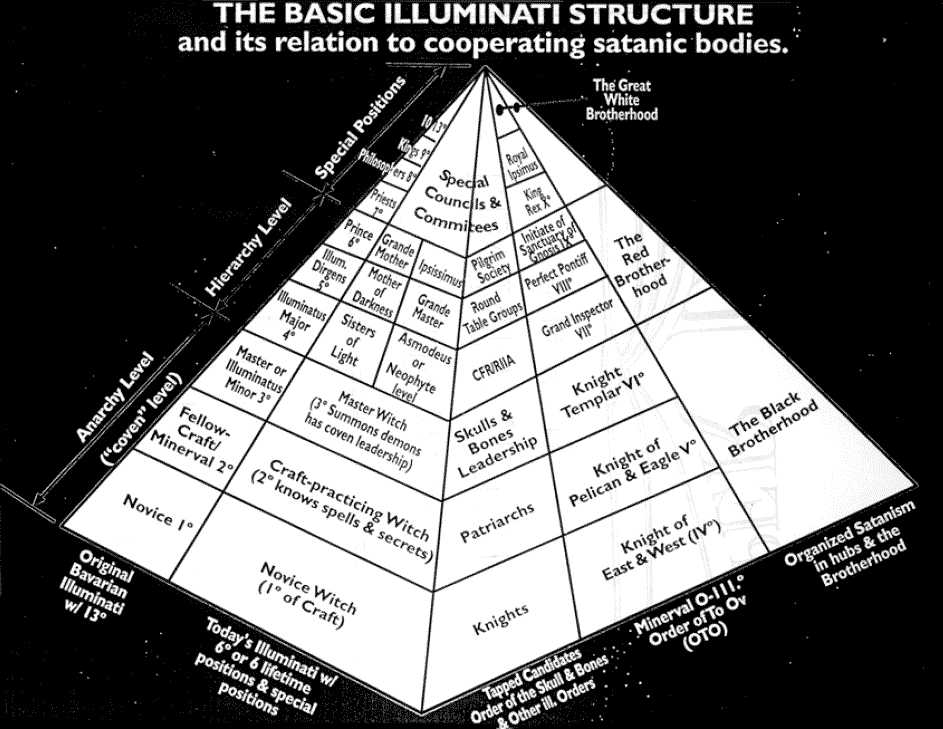
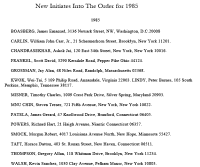 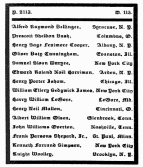 
New Initiates Into
The Order for 1985
Initiates for 1917
The Tomb
Introduction for 2002 Edition
AMERICAS SECRET ESTABLISHMENT has had an unusual publishing history.
The book began with an anonymous donation to the author of an 8-inch
package of documents in the early 1980s. Nothing less than the
membership list and supporting documents for a truly secret society
the Yale Skull and Bones.
The late Johnny Johnson, of Phoenix Arizona was the spark that moved
me to write first a four-part series and later, a jumbo volume based
on this material. This volume went to several editions with several
publishers, even a Russian edition of 12,000 copies. Probably in the
past few years, as many copies have been sold in Russia as in the
United States.
America's Secret Establishment has had little publicity, few reviews
ignored by mainline distributors yet, has sold steadily for the past
16 years at a rate of several hundred copies a month.
This activity, in turn, has generated other articles and books by
other authors. But my real intent, to generate an exploration of
Hegelian influence in modern America, has not been fulfilled. In
great part, this can be attributed to an educational system based on
a statist-Hegelian philosophy, and which has already achieved the "dumbing
down" of America.
This disastrous, destructive philosophy, the source of both Naziism
and Marxism, has infected and corrupted our constitutional republic.
Much of the blame for this corruption is with an elitist group of
Yalie "Bonesmen." Their symbol of Skull and Bones, and their
Hegelian philosophy, says it all, although with typical duplicity,
they would have you believe otherwise.
Hegelianism glorifies the State, the vehicle for the dissemination
of statist and materialist ideas and policies in education, science,
politics and economics.
Wonder why we have a "dumbed-down" society?
Look no further than the Bonesman troika who imported the Prussian education system into the
U.S. in the 19th Century. A political philosophy in direct
opposition to the classical liberalism nurtured in 19th Century
British and American history. In classical liberalism, the State is
always subordinate to the individual. In Hegelian Statism, as we see
in Naziism and Marxism, the State is supreme, and the individual
exists only to serve the State.
Our two-party Republican-Democrat (one Hegelian party, no one else
welcome or allowed) system is a reflection of this Hegelianism. A
small group - a very small group - by using Hegel, can manipulate,
and to some extent, control society for its own purposes.
More than that, reflect on their pirate flag. An emblem found on
poison bottles, the symbol of the Nazi Death Head Division in World
War Two. Not only did Skull and Bones become a major force in drug
smuggling (the Bush and Prescott families in the 1860s), but in true
Hegelian fashion, generated the antithesis, the so-called "war on
drugs." This hypocritical policy maintains the price of drugs,
controls supply, and puts millions in jail while the gainers, in
great part, are none other than the same "Bonesmen" who pass the
laws to prohibit (Bonesman Taft, 1904).
Right and Left - A Control Device
For Hegelians, the State is almighty, and seen as "the march of God
on earth." Indeed, a State religion.
Progress in the Hegelian State is through contrived conflict: the
clash of opposites makes for progress. If you can control the
opposites, you dominate the nature of the outcome.
We trace the extraordinary Skull and Bones influence in a major
Hegelian conflict: Naziism vs. Communism. Skull and Bones members
were in the dominant decision-making positions - Bush, Harriman,
Stimson, Lovett, and so on - all Bonesmen, and instrumental in
guiding the conflict through use of "right" and "left." They
financed and encouraged the growths of both philosophies and
controlled the outcome to a significant extent. This was aided by
the "reductionist" division in science, the opposite of historical
"wholeness." By dividing science and learning into narrower and
narrower segments, it became easier to control the whole through the
parts.
In education, the Dewey system was initiated and promoted by Skull
and Bones members. Dewey was an ardent statist, and a believer in
the Hegelian idea that the child exists to be trained to serve the
State. This requires suppression of individualist tendencies and a
careful spoon-feeding of approved knowledge. This "dumbing down" of
American education is not easily apparent unless you have studied in
both foreign and domestic U.S. universities - then the contrast
becomes crystal clear.
This dumbing down is now receiving attention. Two excellent books
are
The Deliberate Dumbing Down of America, by
Charlotte Thomson Iserbyt, and The Dumbing Down
of America, by John Taylor Gotta. Both books trace this process to
the impact of education, and both give remarkable detail of the
process. We go further, in that we trace the import of the system to
three Yalies members of Skull & Bones.
For Iserbyt, in The Deliberate Dumbing Down of America, the American
education system begins with Rockefeller and Gates. But in fact,
this statist system is a reflection of the Hegelian ideas brought to
the United States by the Skull and Bones "troika" of Gilman,
White
and Dwight, and then financed by Rockefeller.
People Control
Today in California, one can see in real time the use of controlled
conflict to achieve a desired outcome. The debate over the energy
crisis is carefully contained to a debate over price caps and price
control. Republicans want no caps and no controls. Most Democrats
want price controls through caps.
But look at what is NOT discussed anywhere. The entire spectrum of
almost free energy, based on a decade of research is carefully kept
out of the discussion. Isn't this highly relevant to an energy
crisis?
In fact, the existence of free energy systems just down the road is
the reason for the controlled debate. Mills Blacklight Power now has
its patents and some utilities have already bought in.
Bearden's MEG
energy from space, is under discussion. Working models exist. The
maligned cold fusion has hundreds of successful experiments, but so
far as we know, cannot be repeated with sufficient assurance. Other
systems have come into the view of government agencies, and then
disappear from sight.
A knowing public would ask, Why are these not included in the
discussion?" - Simple. Because the utilities know they are for real,
and only a few years down the road. The problem for utilities is not
the price of energy today, but how to dump their fixed assets (hydro
plants, transmission lines, etc.) onto the public. These "valuable"
assets will have zero value down the road, because all new systems
are stand-alone units which don't need fixed plant and transmission
lines. If the public is aware of the dilemma of the utilities, the
ability to dump assets onto the State is heavily reduced.
The Republican-Democrat debate over "caps" is a diversion. The
relevant question carefully avoided is, how long will it take to get
these new systems into production?
Another example is Monsanto Corporation development of genetic
engineering and predator seed, a barely-concealed effort for world
domination of agriculture.
President
George Bush, Jr. , a Bonesman, appoints a Monsanto vice
president, Dr. Virginia Weldon, as Director of Food and Drug
Administration, which has the power to block labeling of
genetically-engineered foods, and pass on other corporate control
efforts.
Just before this, in New Technology, we had the 1989 dramatic
announcement of "cold fusion." When this announcement was made
public, President George Bush (also a Bonesman) called establishment
scientist the late physicist Seagrum into his office and gave
instructions.
We don't know what was said, but we know what happened. Cold fusion,
a valid process for free energy, as was subsequently revealed, was
slandered and harassed by the establishment, no doubt fearful of
what
free energy would do to the oil industry.
What is to be Done?
If the voting public was even vaguely aware of this rampant and
concealed scenario, it could, and possibly would force change.
However, this is not a likely possibility. Most people are
"go-along" types, with limited personal objectives and a high
threshold for official misdeeds.
What has taken over a century to establish cannot be changed in a
few years. The initial question is education. To eliminate the
Hegelian system that stifles individual initiative and trains
children to become mindless zombies, serving the State.
We need a lot less propaganda for "education" and a more individual
creative search for learning. Instead of more money for education,
we need to allocate a lot less. The existing system of education is
little more than a conditioning mechanism. It has little to do with
education in the true sense, and a lot to do with control of the
individual.
It is more likely that time, rather than the voting booth, will
erode the secret power of this Yale group, Nothing this outrageous
can survive forever.
Antony Sutton
Return to Contents
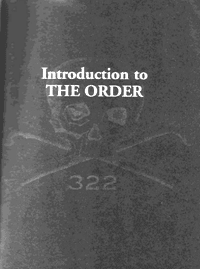
Memorandum Number One:
Is There A Conspiracy Explanation For Recent
History?
The reader anxious to get into the story of
The Order should go
directly to Memorandum Number Two. This section concerns methods,
evidence and proof. Essential, but perhaps boring for most readers.
During the past one hundred years any theory of history or
historical evidence that falls outside a pattern established by the
American Historical Association and the major foundations with their
grant making power has been attacked or rejected - not on the basis
of any evidence presented, but on the basis of the acceptability of
the argument to the so-called Eastern Liberal Establishment and its
official historical line.
The Official Establishment History
There is an Establishment history, an official history, which
dominates history textbooks, trade publishing, the media and library
shelves. The official line always assumes that events such as wars,
revolutions, scandals, assassinations, are more or less random
unconnected events.
By definition events can NEVER be the result of
a conspiracy, they can never result from premeditated planned group
action. An excellent example is the Kennedy assassination when,
within 9 hours of the Dallas tragedy, TV networks announced the
shooting was NOT a conspiracy, regardless of the fact that a
negative proposition can never be proven, and that the investigation
had barely begun.
Woe betide any book or author that falls outside the official
guidelines. Foundation support is not there. Publishers get cold
feet. Distribution is hit and miss, or non-existent.
Just to ensure the official line dominates, in 1946 the Rockefeller
Foundation allotted $139,000 for an official history of World War
Two. This to avoid a repeat of debunking history books which
embarrassed the Establishment after World War One.
The reader will
be interested to know that The Order we are about to investigate had
great foresight, back in the 1880s, to create both the American
Historical Association and the American Economic Association (most
economists were then more historians than analysts) under their
terms, with their people and their objectives. Andrew Dickson White
was a member of The Order and the first President of the American
Historical Association.
Failure of Official History
Times have changed.
The weaknesses, inconsistencies and plain
untruths in official history have surfaced. In the 1980s it is rare
to find a thinking reader who accepts official history. Most believe
it has been more or less packaged for mass consumption by naive or
greedy historians. Although an historian who will stick out his neck
and buck the trend is rare, some who do are victims of an even
deeper game.
Conspiracy then is an accepted explanation for many
events at the intelligent grass roots level, that level furthest
removed from the influence of The Order.
We can cite at random:
-
the
Kennedy assassination where the official "lone gunman" theory was
never accepted by Americans in the street
-
Watergate, where a "deep
throat" informer and erased tapes reek of conspiracy
-
Pearl
Harbor, where Rear Admiral Husband E. Kimmel and Major General
Walter C. Short took the rap for General George C. Marshall and
President Franklin D. Roosevelt
The revisionist historian has a double burden as well as a double
task. The double burden is that research likely to question the
official historical line will not get financed. The double task is
that research must be more than usually careful and precise.
A non-official work is not going to be judged on its merits. The
work will be judged on the basis of its acceptability to a
predetermined historical standard. What this standard is we shall
explore later.
Hypotheses and Method
Which brings us to methodology.
In this volume we will present three
hypotheses. What is a hypothesis? A hypothesis is a theory, a
working theory, a start point, which has to be supported by
evidence. We arrived at these three hypotheses by examining certain
documents which will also be described. The official history hatchet
mongers will scream that our hypotheses are now being presented as
proven assertions - and whatever we write here will not stop the
screams. But again, these are only hypotheses at this point, they
have to be supported with evidence. They are a first step in a
logical research process.
Now in scientific methodology a hypothesis can be proven. It cannot
be disproven. It is up to the reader to decide whether the evidence
presented later supports, or does not support, the hypotheses.
Obviously no one author, critic, or reader can decide either way
until all the evidence has been presented.
We also intend to use two other principles of scientific research
ignored by official establishment historians.
-
Firstly, in science the simplest explanation to a problem is always
the most acceptable solution. By contrast, in establishment history,
a simple answer is usually criticized as "simplistic." What the
critic implies is "The poor writer hasn't used all the facts." In
other words, it's a cheap "putdown" without the necessity of
providing an alternate answer or additional facts.
-
Secondly, again in science, an answer that fits the most cases,
i.e., the most general answer, is also the most acceptable answer.
For example, you have 12 events to explain and a theory that fits 11
of these events. That theory is more acceptable than a theory that
fits only 4 or 5 of the events.
The Devil Theory of History
Using this methodology we are going to argue and present detailed
precise evidence (including names, dates and places) that the only
reasonable explanation for recent history in the United States is
that there exists a conspiracy to use political power for ends which
are inconsistent with the Constitution.
This is known by the official historians as the "devil theory of
history," which again is a quick, cheap device for brushing facts
under the rug. However, these critics ignore, for example, the
Sherman Act, i.e., the anti-trust laws where conspiracy is the basic
accepted theory. If there can be a conspiracy in the market place,
then why not in the political arena? Are politicians any purer than
businessmen? Following the antitrust laws we know that conspiracy
can only be proven in a specific manner.
A similar pattern of market
actions is not proof of conspiracy. Just because something looks
like a duck, walks like a duck, and all the ducks act similarly,
does not make it a duck - or a conspiracy. Under the Sherman Act a
similar pattern of prices, where all prices are the same, is not
proof of conspiracy. Similarity of prices can occur in a purely
competitive market. Neither is similar political action necessarily
a conspiracy.
Proof of conspiracy requires specific types of evidence, i.e.:
(a)
there must be secret meetings of the participants and efforts made
to conceal joint actions
(b) those meetings must jointly
agree to take a course of action
(c)
and this action must be illegal
The Council on Foreign Relations
Widely accepted explanations of recent history based on a conspiracy
theory do not present evidence that fits the above criteria. For
example,
the Council on Foreign Relations cannot be claimed as a
conspiracy even for the period since its founding in 1921.
Membership in the CFR is not a secret. Membership lists are freely
available for the cost of a postage stamp. There is no proof that
the entire membership conspires to commit illegal acts.
What has to be proven in any conspiracy explanation of history is
that the participants have secret groupings, and meet to plan
illegal actions.
Members of the CFR, when accused of being involved in a conspiracy,
have protested to the contrary. And by and large they are right.
Most CFR members are not involved in a conspiracy and have no
knowledge of any conspiracy. And some personally known to the author
are about the last people on earth to get involved in an illegal
conspiracy.
HOWEVER, there is a group WITHIN the Council of Foreign Relations
which belongs to a secret society, sworn to secrecy, and which more
or less controls the CFR. CFR meetings are used for their own
purposes, i.e., to push out ideas, to weigh up people who might be
useful, to use meetings as a forum for discussion.
These members are in The Order. Their membership in The Order can be
proven. Their meetings can be proven. Their objectives are plainly
unconstitutional. And this ORDER has existed for 150 years in the
United States.
Return to Contents
Memorandum Number Two:
The Order - What It Is And How It
Began
THOSE on the inside know it as The Order. Others have known it for
more than 150 years as Chapter 322 of a German secret society. More
formally for legal purposes, The Order was incorporated as The
Russell Trust in 1856. It was also once known as the "Brotherhood of
Death." Those who make light of it, or want to make fun of it, call
it "Skull & Bones," or just plain "Bones."
The American chapter of this German order was founded in 1833 at
Yale University by General William Huntington Russell and Alphonso
Taft who, in 1876, became Secretary of War in the Grant
Administration. Alphonso Taft was the father of William Howard Taft,
the only to be both President and Chief Justice of the United
States.
What Is The Order?
The Order is not just another campus Greek letter fraternal society
with passwords and handgrips, common to most campuses. Chapter 322
is a secret society whose members are sworn to silence. It only
exists on the Yale campus (that we know about). It has rules. It has
ceremonial rites. It is not at all happy with prying, probing
citizens - known among initiates as "outsiders" or "vandals."
Its
members always deny membership (or are supposed to deny membership)
and in checking hundreds of autobiographical listings for members we
found only half a dozen who cited an affiliation with Skull & Bones.
The rest were out. An interesting point is whether the many members
in various Administrations or who hold government positions have
declared their members in the biographical data supplied for FBI
"background checks.
Above all, The Order is powerful, unbelievably powerful. If the
reader will persist and examine the evidence to be presented - which
is overwhelming - there is no doubt his view of the world will
suddenly come sharply into focus, with almost frightening clarity.
Before we go further we need to add a couple of important
observations about The Order:
It is a Senior year society which exists only at Yale. Members are
chosen in their Junior year and spend only one year on campus, the
Senior year, with Skull & Bones. In other words, the organization is
oriented to the post graduate outside world. The Order meets
annually - patriarchs only - on Deer Island in the St. Lawrence
River.
Senior societies are unique to Yale. There are two other senior
societies at Yale, but none elsewhere. Scroll & Key and
Wolf's Head
are supposedly competitive societies founded in the mid-19th
century. We believe these to be part of the same network. Rosenbaum
commented in his Esquire article, very accurately, that anyone in
the Eastern Liberal Establishment who is not a member of Skull &
Bones is almost certainly a member of either Scroll & Key or
Wolf's
Head.
What is the significance of the "322" in Chapter 322?
William
Russell imported the society from Germany and so it has been argued
the 322 stands for '32 (from 1832), the second chapter, of this
German organization. Possibly a chapter 320 and a chapter 321 may
exist somewhere. And 323 is the designation of a room within the
Skull & Bones temple at Yale.
Another interpretation is that The Order is descended from a Greek
fraternal society dating back to Demosthenes in 322 B.C. This has
perhaps some credibility because Bones records are dated by adding
322 to the current year, i.e., records originating in 1950 are dated
Anno-Demostheni 2272.
How A Member Is Chosen By The Order?
The selection procedure for new members of The Order has not changed
since 1832. Each year 15, and only 15, never more, never fewer 1, are
selected. In the past 150 years about 2500 Yale graduates have been
initiated into The Order. At any one time about 500-600 are alive
and active. Roughly about one-quarter of these take an active role
in furthering the objectives of The Order. The others either lose
interest or change their minds. They are silent drop-outs.
1 Readers who want more on the
ceremonial and initiation aspects
should read the September. 1977 Esquire article by Ron Rosenbaum. '
The Last Secrets of Skull and Bones` Unfortunately, the article
completely misses the historical significance of Skull & Bones,
although it is an excellent source of lurid details and the
mumbo-jumbo rites
A Yale Junior cannot ask to join. There is no electioneering.
Juniors are invited to join and are given two options: accept or
reject. Apparently some amount of personal information is gathered
on potential members.
The following is the kind of evaluation made
in the last century; we doubt it has changed too much down to the
present time:
-
"Frank Moore is an ideal Bones man, he is a hard worker and a man
whose efforts have been more for Yale than himself. He is manager of
the Musical clubs and has been active in Dwight Hall. His election
will be well deserved and popular."
-
"Don Thompson is a sure man whom the class wishes well for and
will be glad to see go. He comes from a Bones family."
In selection
emphasis is placed on athletic ability - the ability to play on a
team. The most unlikely potential member of The Order is a loner, an
iconoclast, an individualist, the man who goes his own way in the
world.
The most likely potential member is from a Bones family, who is
energetic, resourceful, political and probably an amoral team
player. A man who understands that to get along you have to go
along. A man who will sacrifice himself for the good of the team.
A
moment's reflection illustrates why this is so. In real life the
thrust of The Order is to ring about certain objectives. Honors
and financial rewards are guaranteed by the power of The Order. But
the price of these honors and rewards is sacrifice to the common
goal, the goal of The Order. Some, perhaps many, have not been
willing to pay this price.
Inside The Order
Entry into The Order is accompanied by an elaborate ritual and no
doubt by psychological conditioning.
For example:
"Immediately on entering Bones the neophyte's name is changed. He is
no longer known by his name as it appears in the college catalogue
but like a monk or Knight of Malta or St. John, becomes Knight so
and so. The old Knights are then known as Patriarch so and so. The
outside world are known as Gentiles and vandals."
The Catalogue (or membership list - it became "Addresses" sometime
in this century) of Chapter 322, however, is made with the usual
"outside" names and is unique and impressive. Each member has a copy
bound in black leather with peculiar symbols on the outside and
inside. The symbols presumably have some meaning.
The owner's name and the single letter "D" is gilt-stamped' on the
outer cover of earlier issues, at least up to the mid-19th century.
It then appears to have been omitted, at least on copies we have
seen: Each right-hand page, printed one side only, about 6 x 4
inches, has the members listed for one year and surrounded by a
heavy black border, thick in the early years, not so thick in recent
decades. This symbolizes the death of the person named as he adopts
his new name and new life upon entering The Order.
Most interesting is an entry between the decade lists of members. On
the 1833 list, before the 15 founders' names, are the words "Period
2 Decade 3." Similarly, before names on the 1843 list are the words
"Period 2 Decade 4." In brief, "Period" stays the same throughout
the years, but the "Decade" number increases by one in each ten
years. No doubt this means something to The Order, else it wouldn't
be there. Another mystical group of letters and numbers is at the
top of the first list of names in 1833, "P.231-D.31." The numbers
increase by one in each succeeding class. In 1834, for example, the
entry reads "P.232-D 32."
Furthermore, the first class list of 1833 has two blank lines in
place of the eleventh name on the list. This supports the argument
that the society has German origins and this is the listing of the
anonymous German connection.
The Members of 1833
We estimate that at any one time only about one-quarter of the
membership is active. Even the active quarter is not always
effective or successful. It's instructive to compare 1833 with 1983
and how, over the century and a half span, a group of 20-30 families
has emerged to dominate The Order.
The very first name on the very first membership list, Samuel Henshaw Bates, was a private in the Union Army, went west to farm in
Santa Rosa, California, at that time very much in the boondocks, and
died in 1879. A life not different to millions of other Americans.
In fact, out of the first 15 members (actually 14 plus the anonymous
member), achievements were not much greater than we would expect
from the cream of a Yale "class". Rufus Hart spent several years in
the Ohio Senate, Asahel Hooker Lewis was in the Ohio Legislature for
a couple of years, Samuel Marshall was an Illinois State Legislator
for a while, and Frederick Mather was in the New York Legislature.
Other members, apart from the two founders of The Order, did nothing
much with their lives or for The Order.
By contrast, the two founding members, William Huntington Russell
and Alphonso Taft, went far. William Russell was a member of the
Connecticut State Legislature in 1846-47, a General in the
Connecticut National Guard from 1862-70, and founded the Collegiate
and Commercial Institute in New Haven, Connecticut. Alphonso Taft
went further: he was Secretary of War in 1876 - the first of several
members of The Order to hold this post down into the 1950s. Taft
became U.S. Attorney General in 1876-7, then U.S. Minister to
Austria in 1882-4, and finally U.S. Ambassador to Russia in 1884-5.
During the 150-year interval since 1833, active membership has
evolved into a core group of perhaps 20 30 families; it seems that
active members have enough influence to push their sons and
relatives into The Order, and there is significant inter-marriage
among the families. These families fall into two major groups.
-
First we find old line American families who arrived on the East
coast in the 1600s, e.g., Whitney, Lord, Phelps, Wadsworth, Allen,
Bundy, Adams and so on.
-
Second, we find families who acquired wealth in the last 100 years,
sent their sons to Yale and in time became almost old line families,
e.g., Harriman, Rockefeller, Payne, Davison.
-
Some families, like the Whitneys, were Connecticut Yankees and
acquired wealth in the nineteenth century.
In the last 150 years a few families in The Order have gained
enormous influence in society and the world.
One example is the Lord family. Two branches of this family date
from the 1630s. Those descended from Nathan Lord and those from
Thomas Lord. Other Lords arrived in the U.S. over the years but do
not enter our discussion. Of these two main branches, only the
Thomas Lord group appears to have contributed members to The Order.
Their ancestry traces to Thomas Lord, who left Essex, England in
1635 in a company led by Rev. Thomas Hooker, and settled in what is
now Hartford, Connecticut. In fact, part of Hartford is still known
as Lord's Hill. The line of descent for this Lord family is full of
DeForest and Lockwood names because intermarriage is more than
common among these elite families.
The first Lord to be initiated into The Order was George DeForest
Lord (1854), a New York lawyer. Together with his father, Daniel
Lord (another Yale graduate), George DeForest Lord established the
New York law firm of Lord, Day and Lord. Among its present day
clients are The New York Times and the Rubin Foundation. The Rubin
Foundation is one of the financial angels for the Institute for
Policy Studies in Washington, D.C.
In the next hundred years five more Lords were initiated into The
Order:
-
Franklin Atkins Lord ('98)
-
William Galey Lord ('22)
-
Oswald Bates Lord ('26)
-
Charles Edwin Lord, II ('49)
-
Winston Lord ('59)
When we ask the question, what have these members
achieved? And what are they doing today? a dramatic picture emerges... as demonstrated in the chart...
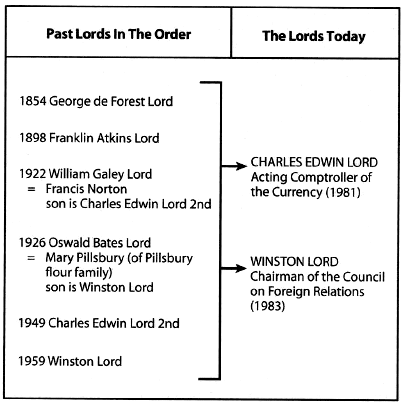
Return to Contents
Memorandum Number Three:
How Much Is Known About The
Order?
The openly published literature on The Order amounts to merely two
articles over a span of one hundred years:
-
The Iconoclast (Volume
One, Number One only) published October 13, 1873
-
An already
cited article in Esquire by Ron Rosenbaum, published in 1977
This
book and its successors are based on unpublished archival material
originating with The Order.
The Iconoclast (October 1873)
Back in October 1873 an enterprising Yale student, stung to action
because The Order had taken over Yale finances and left the
University near poverty, took it upon himself to publish an expose.
Unfortunately, some of the anonymous student's acutest observations
were buried in not-so-good verse. We will reprint some of the verse
below as in the original Iconoclast because it's impossible to
summarize.
The Yale college newspapers, Courant and Record, had a blackout
policy on The Order. As Iconoclast puts it,
"We speak through a new publication, because the college press is
closed to those who dare to openly
mention 'Bones'."
The College Press was controlled by The Order. From time to time
Yale newspapers were run by Editors in The Order. For example, one
noteworthy editor of the Yale Record also in The Order was Thomas
Cochran ('94), who went on to make a career as an influential
partner in the influential banking firm of J.P. Morgan.
Three paragraphs in this anonymous publication summarize the
Iconoclast accusation.
First, there is a Yale secret society open only to a select few:
"For more than forty years a secret society called
Skull and Bones
has existed in Yale College. It receives a certain number of men
from each class. These are chosen nominally by the members of the
class..., although it is understood that a prominent man's
influence avails for his friends and relatives through several years
after his graduation.
By observing the men elected from year to
year, we find that they are chosen with a distinct end in view,
namely, that of obtaining for the society the most honors. Some of
these honors are given to literary, some to wealthy men. This, then,
is the case. Men receive marks of distinction from Yale College or
from their entire class, because of which they are taken into this
secret society. Since Yale honors men, this fraternity professes to
honor them also."
Secondly, the Iconoclast states that The Order has obtained control
of Yale, and its members care more for their society than for Yale:
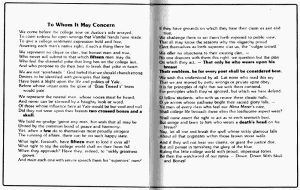
"Out of every class Skull and Bones takes its men. They have gone
out into the world and have become, in many instances, leaders in
society. They have obtained control of Yale. Its business is
performed by them. Money paid to the college must pass into their
hands, and be subject to their will.
No doubt they are worthy men in
themselves, but the many whom they looked down upon while in
college, cannot so far forget as to give money freely into their
hands. Men in Wall Street complain that the college comes straight
to them for help, instead of asking each graduate for his share. The
reason is found in a remark made by one of Yale's and America's
first men: Few will give but Bones men, and they care far more for
their society than they do for the college.' "
Finally, the Iconoclast calls The Order a "deadly evil" growing year
by year:
"Year by year the deadly evil is growing. The society was never as
obnoxious to the college as it is today, and it is just this
ill-feeling that shuts the pockets of non-members. Never before has
it shown such arrogance and self-fancied superiority. It grasps the
College Press and endeavors to rule it all. It does not deign to
show its credentials, but clutches at power with the silence of
conscious guilt.
To tell the good which Yale College has done would be well nigh
impossible. To tell the good she might do would be yet more
difficult. The question, then, is reduced to this - on the one hand
lies a source of in calculable good, -on the other a society guilty
of serious and far-reaching crimes. It is Yale College against Skull
and Bones!! We ask all men, as a question of right, which should be
allowed to live?"
The power of The Order is put to use on behalf of its members even
before they leave Yale. Here's a case from the late 19th century
which predates the cases we will present later and suggests how long
immoral use of power has prevailed within The Order:
"The Favoritism Shown To Bones Men"
"Are not we coming to a sad state when open injustice can be done by
the Faculty, and when the fact that a man is a member of Skull and
Bones can prejudice them in his favor? Briefly, the case which calls
forth this question is this: Two members of the Senior class, the
one being a neutral, the other a Bones man, returned at the
beginning of the college year laden with several conditions, some of
which, upon examination, they failed to pass.
Up to this point the
cases were parallel, and the leniency, if there was to be leniency,
should have been shown to the neutral, who has done all that lay in
his power to further the interests of the college, rather than to
the Bones man, who has, during his three years at Yale, accomplished
nothing that we won of. But, strange to say, the former has been
suspended until the end of the term and obliged to leave town, not
being permitted to pass another examination until he returns.
The
Bones man, on the contrary, is allowed to remain in New Haven,
attends recitation daily, is called upon to recite, and will have a
second examination in less than six weeks. Why is this distinction
made? 'O, Mr. So-and-so's is a special case,' said a professor (a
Bones man), - the specialty, we presume, being the fact that Mr.
So-and-so wears a death's head and cross bones upon his bosom.
We
understand that Mr. So-and-so claims to have been ill during
vacation and offers the illness as an excuse for not passing the
examination; but the neutral gentleman was also ill, as the Faculty
were expressly informed in a letter from his father."
"The circumstance has caused a very lively indignation throughout
the Senior class. It is certainly time for a radical reform when the
gentlemen who superintend our destinies, and who should be just if
nothing else, can allow themselves to be influenced by so petty a
thing as society connections."
Esquire (September 1977)
Only one article is known to have been published within the last 100
years on The Order. Unfortunately, it is a superficial, almost
mocking, review and provides some enlightenment but little
contribution to historical knowledge. The article is the "Last
Secrets of Skull and Bones" by Ron Rosenbaum (Esquire, September
1977).
Rosenbaum is a Yale graduate attracted by the fictional
possibilities of a secret society out to control the world; he is
apparently not aware of the political implications. The contribution
is a blend of known authentic documents and outright hearsay. On the
other hand, Rosenbaum does make some notable observations.
Among
these are:
"... the people who have shaped America's national
character since it ceased being an undergraduate power had their
undergraduate character shaped in that crypt over there" (i.e., the
"temple" on the Yale campus).
Another comment: when a new member is initiated into The Order,
"tonight he will die to the world and be born again into The Order
as he will thenceforth refer to it. The Order is a world unto itself
in which he will have a new name and fourteen new blood brothers,
also with new names."
And when Rosenbaum starts to inquire about The Order, he is told:
"They don't like people tampering and prying. The power of Bones is
incredible. They've got their hands on every lever of power in the
country. You'll see - it's like trying to look into the Mafia.
Remember they're a secret society too."
The Esquire piece is well
worth reading, it gives a side of The Order that doesn't concern us
too much.
The "Addresses" Books
As The Order is a secret society it does not publish minutes or
journals. As Rosenbaum suggests, "they don't like people tampering
and prying."
This author does, however, possess copies of the "Addresses" books,
which used to be called "Catalogues." These are the membership lists
all the way back to 1832, the founding date in the United States.
How did this material make its way into outside hands? It is
possible that one or more members, although bound by oath, would not
be dismayed if the story became public knowledge. That's all we will
say.
Other material exists, Skull & Bones is always a lively topic for
Yale conversation. Some time back a few practical minded students
made their own investigation; they did a break-in job, a "Yalegate."
A small hoard of Bones momentos, a layout diagram and considerable
embarrassment resulted.
The core of the research for this book is the "Addresses" books.
With these we can reconstruct a picture of motives, objectives and
operations. The actions of individual members are already recorded
in open history and archives.
By determining when members enter a scene, what they did, what they
argued, who they appointed and when they faded out, we can assemble
patterns and deduce objectives.
Return to Contents
Memorandum Number Four:
Who Is In This Secret Society?
The membership list of about 2500 initiates into The Order has very
obvious features:
-
Most members are from the Eastern seaboard United States. As late as
1950 only three members resided in Los Angeles, California, but 28
members resided in New Haven, Connecticut.
-
Members are all males and almost all
WASPS (White Anglo Saxon
Protestant). In great part they descended from English Puritan
families, their ancestors arrived in North America in the 1630-1660
period.
-
These Puritan families either intermarried with financial power or
invited in sons of money moguls, e.g., Rockefellers, Davisons, and
Harrimans, whose sons became members of The Order.
From this preliminary information we can derive Hypothesis One:
THERE EXISTS IN THE UNITED STATES TODAY, AND HAS EXISTED SINCE 1833,
A SECRET SOCIETY COMPRISING MEMBERS OF OLD LINE AMERICAN FAMILIES
AND REPRESENTATIVES OF FINANCIAL POWER.
The chart on page 19 below, presents a simplified layout of this
hypothesis. Full information remains for a later book - for now
we'll give details of just two key families, the Whitneys and
the Harrimans.
The Whitney Family
A key family is the Whitneys, descended from English Puritans who
came to the U.S. about 1635 and settled in Watertown, Mass. Eight
Whitneys have been members of The Order. Of these, three had brief
lives; Emerson Cogswell Whitney died a few months after initiation
and Edward Payson Whitney "disappeared in 1858" according to his
biographer.
However, three Whitneys, William Collins Whitney and his
two sons, are the core of Whitney influence in The Order which
survives today through the Harriman family and intermarriage with
Paynes and Vanderbilts.
Whitneys In The Order:
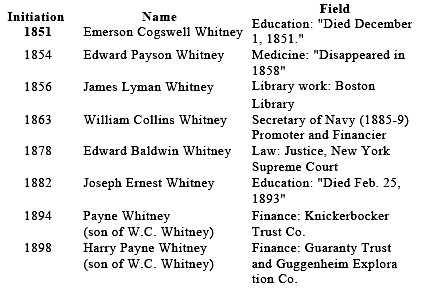
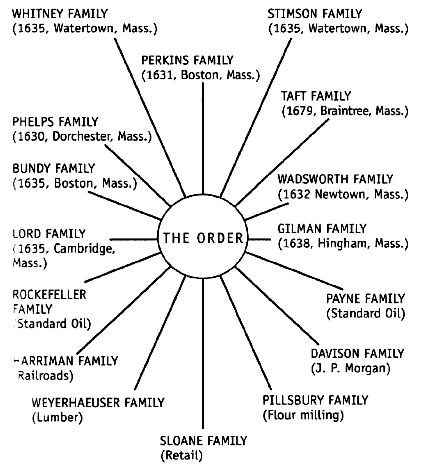
William Collins Whitney (1841-1904) is a fine example of how members
of The Order rise to fame and fortune. W.C. Whitney was initiated in
1863 and by 1872 had only advanced his career to Inspector of
Schools for New York.
However, in the last three decades of the
century, he rolled up a massive fortune, became a power behind the
throne in the Cleveland Administration, and directed the often
unscrupulous activities of a cluster of capitalists known as "the
Whitney Group". A brief quotation suggests the power that Whitney
amassed in a brief 30 years.
This is a list of Whitney estates at
the turn of the century:
"... a city residence in New York, a Venetian palace and 5,000
acres in Wheatley Hills, near Jamaica, L.I.; a Sheepshead Bay house,
with a private track covering 300 acres; a mansion at Berkshire
Hills, Mass., with 700 acres of land; October Mountain house, with a
large tract of land; Stony Ford Farm, New York, used as an auxiliary
to his Kentucky Stock Farm; an Adirondack game preserve of 16,000
acres; a lodge at Blue Mountain Lake with a fine golf course, a Blue
Grass farm of 3,000 acres in Kentucky; and an estate at Aiken,
S.C., comprising a mansion, race course, and 2,000 acres of hunting
land."
William C. Whitney married Flora Payne, daughter of Standard Oil
Treasurer Oliver Payne. The Paynes are not in The Order, but adding
the Payne piece of the Standard Oil fortune made Whitney's fortune
that much larger. Their two sons, Harry Payne ('94) and Payne
Whitney ('98), went to Yale and became members of The Order.
After
Yale Harry Payne promptly married Gertrude Vanderbilt in 1896 and so
the Whitney-Payne fortune now joined some Vanderbilt money. This
financial power was channeled into Guaranty Trust, the J.P. Morgan
and Guggenheim outfits.
And it gets more complicated. For example, the son of Harry Payne
Whitney, Cornelius Vanderbilt Whitney, married Marie Norton. After
their divorce, Marie Norton Whitney married W. Averell Harriman (his
first wife) who is today at 91 a key member. It is these tightly
woven family and financial interlocks that make up the core of The
Order.
So let's take a look at the Harriman family.
The Harriman Family
In the first few days of June 1983 a prominent American, a private
citizen, flew to Moscow for a confidential chat with Yuri Andropov.
A State Department interpreter went along.
This American was not the President, nor the Vice-President, nor the
Secretary of State, nor any member of the Reagan Administration. It
was a private individual - W. Averell Harriman. The first time any
American had talked with Yuri Andropov since the death of his
predecessor, Brezhnev. So who is W. Averell Harriman?
The elder Harriman, a prominent and not too scrupulous railroad
magnate, sent both his sons to Yale. William Averell Harriman ('13)
and Edward Roland Noel Harriman ('17) joined The Order.
A good
example of how old line families in The Order absorbed new wealth
families, although as history has unfolded it may be that Harriman
and his fellow investment bankers have dominated the direction of
The Order in the past few decades.
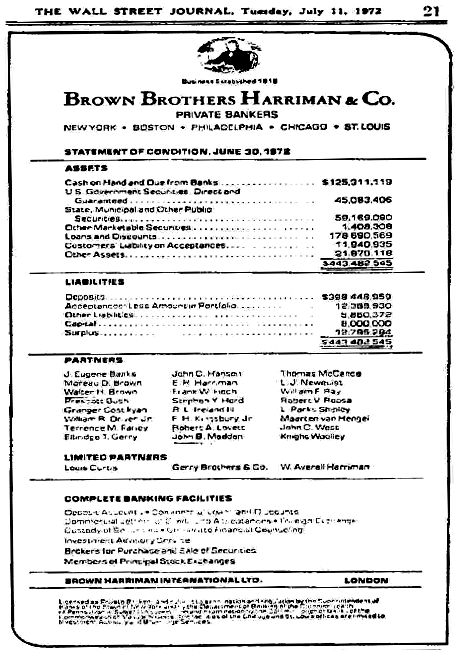
Brown Brothers Harriman, advertisement from Wall Street Journal
listing partners.
In the 1930s W.A. Harriman & Company merged with Brown Brothers.
This was an older financial house whose partners were also members
of The Order. Alexander Brown was founded 1800 in New York and
Philadelphia.
By the 1970s the relatively unknown private international banking
firm of Brown Brothers, Harriman, with assets of about one-half
billion dollars, had taken in so many of "the Brotherhood" that out
of 26 individual partners, no fewer than 9 were members of The
Order. We don't know of any greater concentration of members.
And to make it more interesting, Prescott Bush, father of President
George H. W. Bush (both in The Order), was a partner in Brown
Brothers, Harriman for over 40 years.
Finally, because Brown Brothers, Harriman is a private banking firm
it has relatively no government supervision and does not publish an
annual report. In other words, we know NOTHING about its operations
-at least we know nothing from Brown Brothers, Harriman sources.
Here's a line-up of Brown Brothers, Harriman partners who were also
members of The Order in the mid 1970s:
Name of Partner Date Initiated
-
Walter H. Brown 1945
-
Prescott Sheldon Bush 1917
-
Granger Kent Costikyan 1929
-
Edward Roland Noel Harriman 1917
-
W. Averell Harriman 1913
-
Stephen Young Hord 1921
-
Robert Abercrombie Lovett 1918
-
John Beckwith Madden 1941
-
Knight Woolley 1917
It's worth thinking about this concentration of names and the power
it represents in the light of outside comments on The Order over the
years.
After the title page of this volume we reprint the verse of an
anonymous Yale student of the 1870s. He commented on the requirement
to put The Order ahead of all else.
The Editor of The Iconoclast (also in the 1870s) wrote:
And on their breasts they wear a sign
That tells their race and name
It is the ghastly badge of death
And from his kingdom came
The son
of
Satan, son of sin
The enemy of man.
Another writer in the 1870s called The Order the "Brotherhood of
Death":
Outside already, in the doubtful dawn,
Thither, from this side and from that, slow sweep,
And settle down
in silence solidly,
Crow-wise, the frightful Brotherhood of Death.
Black-hatted and
black-hooded huddle they,
With black cravats a-dangling from each neck;
So take they
their grim station at the door,
Torches lit, skull-and-cross-bones-banner spread.
Ron Rosenbaum
in his 1977 Esquire article a century later, was no
less caustic. Rosenbaum called it a Mafia.
From evidence to be presented later this author would term The Order
"an international Mafia" ... unregulated and all but unknown. To
the outside world, however, it's merely Brown Brothers, Harriman, 59
Wall Street, New York. But obviously Yuri Andropov over in Moscow
knows who holds the cards.
The British Connection
Some well read readers may raise a question - how does The Order
and
its families relate to
Cecil Rhodes secret society, Milners Round
Table,
the Illuminati and the Jewish secret society equivalents? How
do these fit into the picture?
We are concerned here only with the core of a purely American
phenomenon with German origin. It is undoubtedly linked to overseas
groups. The links between The Order and Britain go through Lazard
Freres and the private merchant bankers. Notably the British
establishment was also founded at a University - Oxford University,
and especially All Souls College at Oxford. The British element is
called "The Group."
The Group links to the Jewish equivalent through
the Rothschilds in
Britain (Lord Rothschild was an original member of Rhodes "inner
circle"). The Order in the U.S. links to the Guggenheim, Schiff and
Warburg families. There were no Jews at all in The Order until very
recently. In fact, The Order has, as Rosenbaum suggests, some
definite anti-semitic tendencies. Token Jews (and token blacks) have
been admitted in recent years.
There is an Illuminati connection. Some details are in the Esquire
article, more details will be in our future volumes.
All these groups have cooperative and competitive features. But to
argue that all the world's ills can be ascribed to any one of these
groups is false. The core of The Order, like the core of "The Group"
in England, comprises about 20 families. In the U.S. case they are
mostly descendents from the original settlers in Massachusetts.
New
wealth did not enter The Order until the mid-19th century and until
recently, has
never dominated The Order. On the other hand, key families, the
Whitneys and the Harrimans, are linked to their own banking
interests. In many ways these old line Yankee families have
outsmarted the bankers.
The Puritans diverted bankers' wealth to
their own objectives without always absorbing the banker families.
The Order controls the substantial wealth of Andrew Carnegie, but no
Carnegie has ever been a member of The Order. The Order used the
Ford wealth so flagrantly against the wishes of the Ford family that
two Fords resigned from the board of the Ford Foundation. No Ford
has been a member of The Order.
The name Morgan has never appeared
on the membership lists, although some Morgan partners are with the
inner core, for example, Davison and Perkins. Interestingly, the
Astor name is prominent in "The Group" in England, but not in The
Order in the U.S.
Return to Contents
|









